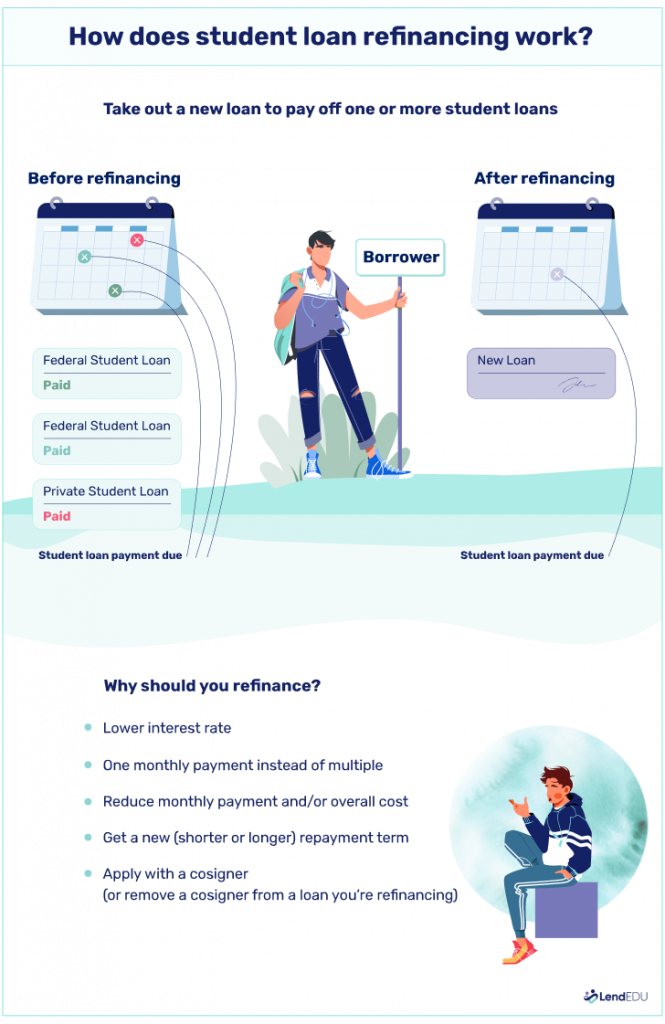Refinancing student loans can streamline repayment and reduce your interest rate, but you’ll need to meet a lender’s requirements for credit and income to qualify. If you have a low income, getting approved for student loan refinancing can be difficult.
However, there’s no standard income cutoff across the board—requirements will vary by lender. Some lenders want to see that you make at least $30,000 annually, while others don’t have a specific minimum and look at multiple factors when considering your loan application.
The definition of “low income” can vary, too, but it could be an income that falls below federal poverty guidelines, which is currently $14,580 for an individual and $19,720 for a household of two. Here’s a closer look at refinancing student loans with a low income, including how private refinancing compares to federal loan consolidation and your options for both.
Table of Contents
Skip to Section
Low-income student loan refinance options might depend on your loan type
If you took out student loans to pay for school, you may have borrowed federal student loans, private student loans, or a combination of both. Regardless of which loan type you hold, you’ll still need to meet a lender’s criteria for credit and income to get approved for refinancing.
However, federal student loans have an additional option that private loans don’t—the federal Direct Consolidation Loan. Federal student loan consolidation doesn’t have any income or credit requirements.
Consolidating your federal student loans can simplify repayment and get you on a new repayment plan. Unlike refinancing, though, it won’t lower your interest rate.
| Federal student loans | Private student loans | |
| Loan issuer | U.S. Department of Education | Private lender, such as a bank, credit union, or online lender |
| Type of interest rate | Fixed | Fixed or variable |
| Eligible for refinancing? | Yes | Yes |
| Eligible for Direct Consolidation Loan? | Yes | No |
| Must meet income requirements for consolidation? | Yes for refinancing, no for federal loan consolidation | Yes |
You can find a list of all your federal student loans by signing into your account on the Federal Student Aid website with your FSA ID. While there’s no centralized dashboard for private student loans, you can find out who your lender is by checking your loan statements or reviewing your credit report.
Refinance vs. consolidation
Both refinancing and consolidation can combine several loans into one. However, refinancing involves taking out a private student loan in place of your existing loans, while federal loan consolidation involves applying for a federal Direct Consolidation Loan.
Refinancing has the potential to save you money on your loans, but it can be tough to qualify with a low income or weak credit score. By contrast, there are no income or credit requirements for federal loan consolidation, making this a more accessible option for low-income borrowers.
If you’re looking to simplify repayment and don’t have a high enough income for refinancing, a Direct Consolidation Loan may be the better option. You won’t reduce your interest rate, but you can combine your federal loans into one new one and get on a new repayment plan.
Here’s a closer look at how student loan refinancing compares to federal loan consolidation:
| Student Loan Refinancing | Direct Loan Consolidation | |
| Loan issuer | Private lender, such as a bank, credit union, or online lender | U.S. Department of Education |
| Eligible loans | Private and federal student loans | Only federal student loans |
| Potential to reduce interest rate | Yes | No |
| Option to choose new repayment terms | Yes | Yes |
| Can combine multiple loans into one | Yes | Yes |
| Has income and credit requirements | Yes | No |
| May need a cosigner to qualify | Yes | No |

Ask the expert
Engage with a financial professional specializing in refinancing specifically for low-income households. A financial counselor or financial planner who offers pro-bono hours could provide opportunities to not only consolidate student loans but also help with a plan to pay off the debt and other debts. In addition to researching where you can get free or low-cost help, I suggest focusing on the pros and cons of the current loans versus refinancing. Ultimately the determination should be an economic benefit to you as the borrower.
Eligibility and requirements to refinance student loans
These are the typical requirements you’ll have to meet to refinance student loans:
- Minimum income: Lenders usually want to see that you make a certain income to ensure you can repay your refinanced student loan. Some lenders will accept an offer of employment that will begin within the next few months.
- Acceptable debt-to-income ratio: Your DTI compares monthly debt payments with gross income. Lenders usually prefer a DTI under 36%.
- Sufficient credit score: Your credit plays a large role in whether you can get approved for refinancing and the interest rate you get. A good FICO score of 670 or higher will help you access the best rates.
- Education status: Some lenders require that you’ve graduated with your degree, while others will approve current students.
If you don’t have sufficient credit or income to qualify for refinancing, you may still be able to get approved by applying with a cosigner. A cosigner will share responsibility for your debt, though some lenders offer cosigner release after a certain number of payments.
Here’s a closer look at lender requirements for low-income student loan refinance.
Pros and cons of refinancing with low income
There are pros and cons of refinancing student loans with a low income that are worth considering before you apply.
-
Lower your interest rateIt could be tough to qualify for student loan refinance with a low income or weak credit, and your options for lenders may be limited.
-
Choose new repayment termsYou can usually choose repayment terms between five and 20 years.
-
Simplify repaymentIf you refinance multiple loans, you can combine them into one for a single monthly payment.
-
May be difficult to qualifyIt could be tough to qualify for student loan refinance with a low income or weak credit, and your options for lenders may be limited.
-
A lower rate isn’t guaranteedIf your low income is making it difficult to qualify for a better interest rate than you have currently, there wouldn’t be much point to refinancing.
-
Could lose access to federal benefitsRefinancing federal loans means replacing them with a private loan. Your new refinanced loan won’t be eligible for federal protections like federal repayment plans, forbearance, deferment, and forgiveness programs.
How to refinance student loans with low income
If you decide refinancing makes sense for you, here are the steps you can take to apply:
- Check your credit. Along with income, your credit can make or break your student loan refinancing application. Check your score before you apply so you know what you’re working with. Consider enlisting a cosigner if your credit is on the low side.
- Shop around with lenders. Some lenders have more stringent requirements than others, so look for ones that would be a good match for your financial profile. You may be able to check your offers through prequalification, which allows you to see if you can get approved without undergoing a hard credit inquiry.
- Compare your refinance offers. To choose your best offer, look for a loan with a low interest rate, few (or no) fees, and repayment terms that work for your budget. Consider whether the lender offers any other benefits, such as payment modification if you lose your income.
- Choose an offer and apply. If you find an appealing offer, you can submit an official application and any verifying documentation the lender requires. Once everything goes through, you’ll start paying back your new, refinanced student loan.
Ask the expert
Evaluate the new monthly payment you are projected to pay with a refinanced loan. If it does not fit your budget, I would not suggest that they refinance and instead continue to repay your student loans (while also communicating with the lender if you will be late on a payment). Then, reevaluate consolidation when cash flow is more favorable, your credit has (hopefully) increased, interest rates are more favorable, and/or your income has increased.
Alternatives to student loan refinance
If refinancing is not the best option for you, consider these alternatives for managing your private student loans:
- Contact your lender about your options: If you’re concerned about missing payments, contact your lender ASAP to see if it can help. Some options might include temporary forbearance, payment modification, new repayment terms, or an adjusted payment due date.
- Pursue a loan repayment assistance program (LRAP): Although private student loans aren’t eligible for federal forgiveness programs, they may qualify for repayment assistance from your state or a private organization. Most LRAPs are designed for qualified professionals working in high-need or underserved communities.
- Consider a home equity loan or HELOC: Homeowners could tap into their home equity to pay off their student loans. This option could save you money if your home equity loan or HELOC has a better interest rate than your student loans. However, the risk is that you could lose your home to foreclosure if you can’t repay what you borrow.
















